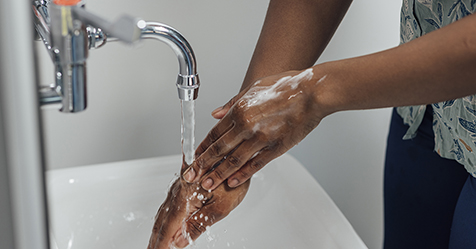The antimicrobial coatings industry has been growing so rapidly and yet so quietly, it is possible that many in the professional cleaning industry are unaware of just how fast it has been expanding. Now considered a billion-dollar industry, antimicrobial coatings are designed to inhibit the growth of germs and bacteria on a variety of surfaces, and health care is the industry that shows the greatest growth and growing demand. North America is the largest regional market for antimicrobial coating products with 35 percent of the market, according to a March 2014 report by Grand View Research. Further, the report says, this market is expected to continue to expand significantly in future years.
Uses for Antimicrobial Coatings
Antimicrobial coatings are typically applied to counters, walls, door handles, and other high-touch areas; HVAC vents and mechanicals; and many other surfaces. In some cases, they are sprayed onto textiles, masks, gloves, and carpeting. Even paint manufacturers are applying them to their wall paint and primer products to inhibit the growth of pathogens in facilities. In hospitals and medical facilities, these coatings are also being applied to medical devices.
According to information provided by Global Industry Analysts, a market research group, “The medical devices segment is all set to witness an impressive growth [in antimicrobial coatings] in coming years. Factors such as the increasing number of hospital-acquired infection (HAI) cases…are encouraging greater use of antimicrobial-coated medical devices.”
Along with helping to inhibit the spread of germs and bacteria on medical instruments, antimicrobial coatings can also impact how we clean health care facilities. If countertops, for instance, are coated with these materials, it means that powerful cleaning agents and disinfectants often used in health care facilities may no longer be necessary. If proven true, this would help reduce the environmental impact of cleaning in medical facilities significantly.
The following are some of the key promises for the significant growth of antimicrobial coatings in recent years:
- They help stop the spread of pathogens that can cause disease, which is especially important in a hospital setting where many people already have weakened immune systems.
- They have the potential to meaningfully lower the environmental impact of cleaning in a medical setting, where scores of different chemicals are used for a variety of purposes.
- If surfaces do not need as thorough a cleaning to prevent the spread of disease, it could reduce the amount of cleaning time—and therefore, cost—necessary to maintain facilities.
For the manufacturers of cleaning solutions and disinfectants, the growth of antimicrobial coating products may be a cause for concern. After all, a lot of money, time, and research have been poured into developing traditional and environmentally certified cleaning products to help stop the spread of disease and keep people in all types of facilities healthy. However, these manufacturers, along with the entire professional cleaning industry, have not yet heard the entire story.
The Flip Side
The U.S. Centers for Disease Control and Prevention (CDC) “has found no evidence to suggest [antimicrobial coatings] offer any enhanced protection from the spread of bacteria and germs and that proper cleaning and handwashing are the best ways to prevent infection.”
Because of this and concerns about the substances used in antimicrobial products, some health care organizations are having second thoughts about the use of these coatings. In fact, Kaiser Permanente, which operates 38 hospitals and more than 600 medical offices in the United States, has recently stopped using these products in its facilities. As of late 2015, the American Coatings Association had not yet determined “what the formal policy will mean for those who manufacture coatings and paints,” according to an article published by Durability + Design. However this eventually plays out, the most important issue has already been raised: the true effectiveness of these coatings
The Lessons
Let’s make sure the promise of cost savings through reduced cleaning does not seduce us until we know conclusively that these compounds work in the real-world and not just a Petri dish.
In addition to determining the efficacy of antimicrobials in surface coatings, let’s avoid another problem like we had with lead in paint. While lead improved the performance of paint, when the paint naturally deteriorated, it resulted in increased exposure to lead, which accumulates in the bodies of young children. Additionally, due to the widespread use of lead paint, the cost of remediation has been staggering as we have struggled to eliminate it since 1978.
What we know for certain is that using proper cleaning solutions and cleaning methods is still the best way to stop the spread of disease and keep people healthy in all types of facilities. Therefore, let’s follow Kaiser Permanente and make sure we have done our due diligence on these new antimicrobial additives before we start their widespread use.
Updated May 15, 2018 from an article originally posted January 29, 2016



